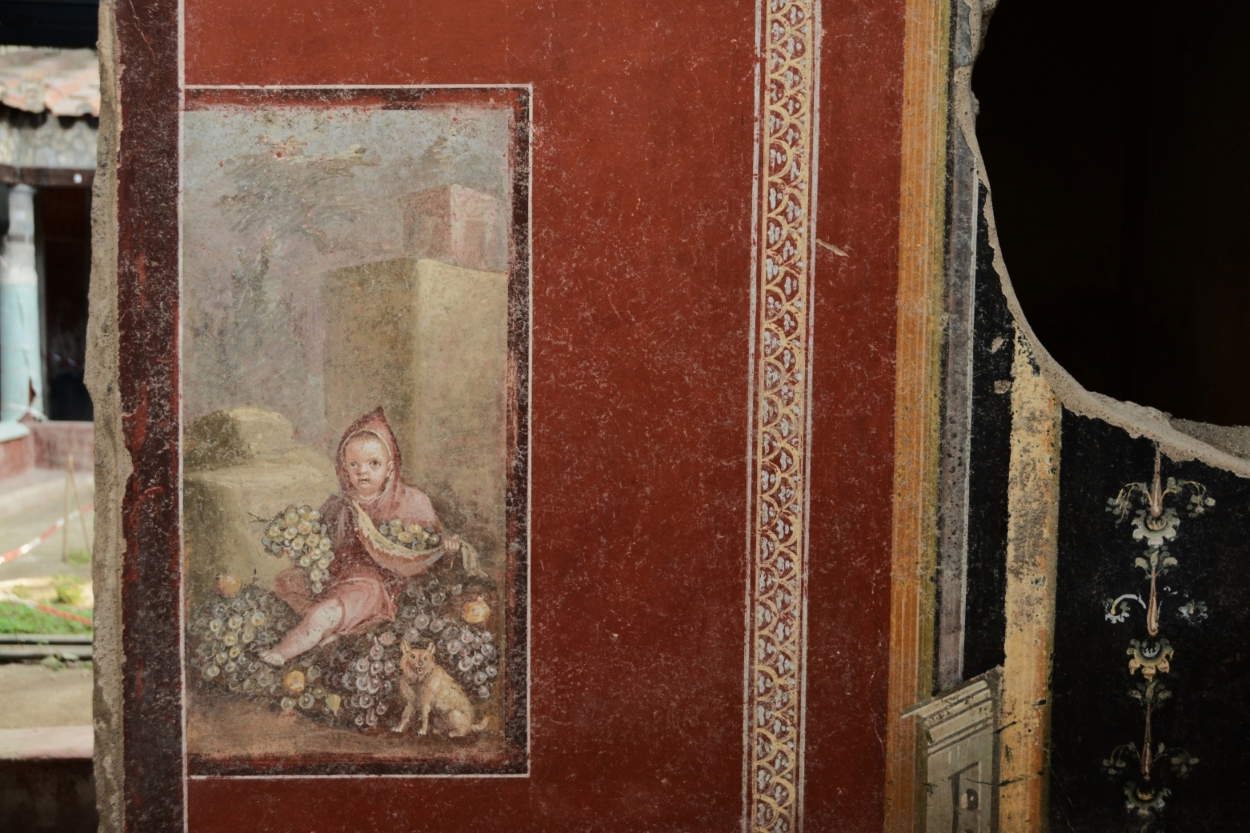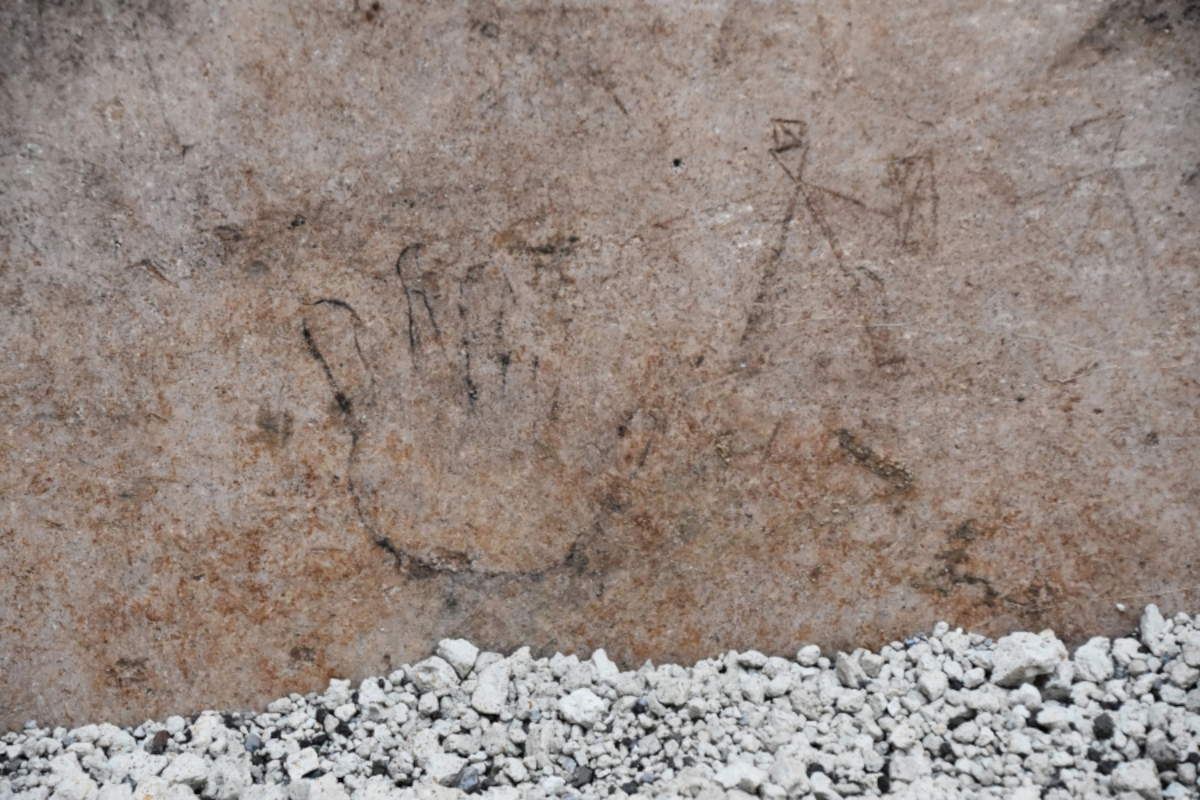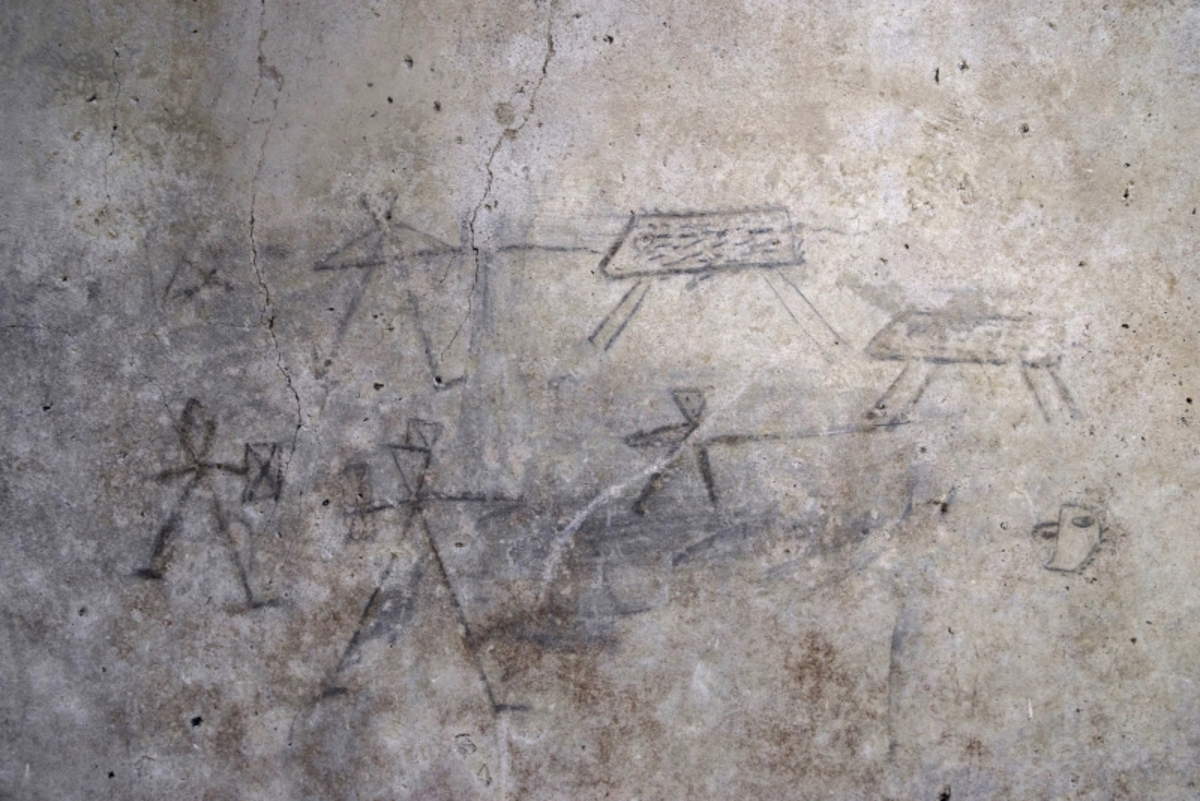Pompeii, the new discoveries in the Insula of the Casti Amanti
As part of the restoration, excavation and accessibility project in the Insula dei Casti Amanti of Pompeii Archaeological Park, which can be visited from May 28, 2024 from above thanks to a system of suspended walkways, new discoveries have been made. Drawings of gladiators probably made by young children with charcoal have emerged on the walls of a service courtyard in the Colonnaded Upper Room house on Via dell’Abbondanza: drawings that help to understand scenes from a Pompeian childhood, according to the text published in theE-Journal of the Pompeii Excavations.
In addition to the children’s drawings, for the study of which the Archaeological Park has initiated a collaboration with the Department of Child Neuropsychiatry of theFederico II University of Naples, the remains of two victims, a woman and a man, who died in the lapilli of Vesuvius in front of the closed door of the House of the Painters at Work (so named for the fact that it was being repainted at the time of the eruption); inside the house, a small cubicle (bedroom), set up as a study near the tablinum (reception room) of the house, also came to light. Among the mythological scenes is a singular picture, without comparison from the Vesuvian repertoire, depicting a small hooded child, possibly a deceased son of the owners.
The environments and findings
Among the rooms that emerged during the archaeological excavations, one was discovered in the House of the Painters at Work with refined frescoed walls in the IV style. The upper portion with a white background turns out to be decorated with mythological figures (centaurs, sirens, griffins) framing the image of a deity, present on each side. Aphrodite, Apollo and Dionysus can be recognized, and a fourth deity (most likely a female figure) not clearly legible, due to a breach in the reference wall. In contrast, the middle register with red background panels has squares painted directly on the color. In the scenes one can recognize Perseus and Andromeda on one side and the purification of a hero on the other. On yet another wall is a smaller quadretto depicting, in a somewhat unprecedented manner, a child wearing a traveler’s hood and cloak, surrounded by large bunches of grapes and pomegranates; at his side is a small dog. Placed near the opening overlooking the triportico (garden with a three-armed portico), the scene creates a play of perspective illusion with the garden.
Another room, also in the House of the Painters at Work, already partially investigated in previous excavation campaigns, was identified as the main entrance to the House of the Painters at Work through the western alley. The excavation here returned the skeletons of two victims, a man and a woman of advanced age who, having entered through the door on the alley, had sought refuge in the fauces (access corridor), a small space still free of the lapilli that fell during the first phase of the eruption, subsequently finding death from the gray lapilli that inevitably came to accumulate.
In the II Cenacle Colonnaded House, on the other hand, during excavation and emptying activities from the eruptive material, some charcoal drawings were discovered on one of the walls of a corridor near a service courtyard, about 1.50 meters from the floor level, which due to the simplicity of execution, the naive nature of the stroke and the simplifications of the iconographic patterns, would appear to have been made by the hand of a child, who had likely climbed onto a scaffold erected for work in progress in the house. The drawings in this room depict, in the preserved parts, a gladiatorial scene, with two gladiators facing each other, and a scene of venatio (hunting games), with two bestiarii, equipped with a long spear, intent on confronting probably a pair of wild boars. On the right, however, is a head of a bird of prey, possibly an eagle.
“Together with the psychologists from the Frederick II, we came to the conclusion that in all likelihood the drawings of gladiators and hunters were made based on direct vision and not from pictorial models,” said director Gabriel Zuchtriegel. “Probably one or more of the children playing in this courtyard, among the kitchens, latrine and vegetable-growing beds, had witnessed fights in the amphitheater, thus coming into contact with an extreme form of spectacular violence, of which executions of criminals and slaves might have been part. The drawings show us the impact of this on the imagination of a young child or girl, subject to the same developmental stages that are still found today. Cephalopods, or figures with legs and arms coming straight out of the head, characterize a way of drawing the human figure that we can find in children today. Evidently this is an anthropological constant that transcends artistic and cultural fashions.”
In another space identified as an area used for both amphora storage/unloading and production purposes, another series of drawings probably at child height, between 0.20 and 0.50 meters from the floor level, appeared on some walls. These are three small hands outlined with charcoal, two gladiatorial scenes, a drawing that would appear to depict two figures playing with a ball, an animal to be recognized likely as a wild boar, and, finally, a boxing scene depicting one of two boxers lying on the ground.
The east wall, in addition to testifying to the presence of another boxing scene, documents a more complex scene belonging to a different hand and to an earlier period in the life of the room (still not well defined), as the drawing is partially covered by a cream-colored scialbatura, perhaps put in place precisely to cover this drawing. The latter was not traced with a charcoal, but with a red mineral pigment, perhaps ochre. The drawing depicts schematically, but with a strong ironic intent, a marine scene, where we recognize two large ships surrounded by fish, objects referring to fishing (creel?) and, under a fish with long wattles, plausibly a mullet, of larger size, two male members, one of them hooked.
“Periodically and increasingly, Pompeii reveals wonderful new discoveries to us and confirms itself as an extraordinary treasure chest,” said Culture Minister Gennaro Sangiuliano. “That is why we in the budget law expressly refinanced the excavations in Pompeii, where there are now so many active construction sites, which day after day bring new wonders to the general attention. After the conclusion of the Great Pompeii Project we want to give an organic arrangement, a stable arrangement to this wonderful site that every day brings tens of thousands of visitors.”
“With the facilitated visit itinerary ’Pompeii for All,’ launched in 2016 and since then the subject of progressive implementations and developments, as well as with the new excavation campaigns that have given the world incredible surprises in recent years, a new, inclusive and engaging approach to the enhancement of the site has been inaugurated,” added Director General of Museums Massimo Osanna. “Today’s opening, the finish line of a complex and important construction site launched as part of the Great Pompeii Project, appears highly significant in this sense. Indeed, it offers the added value of accessibility and full inclusion of all visitors, even with respect to all those behind-the-scenes activities, such as the excavation and restoration work proper to a construction site, which are made visible to all without barriers.”




 |
| Pompeii, the new discoveries in the Insula of the Casti Amanti |
Warning: the translation into English of the original Italian article was created using automatic tools. We undertake to review all articles, but we do not guarantee the total absence of inaccuracies in the translation due to the program. You can find the original by clicking on the ITA button. If you find any mistake,please contact us.




























